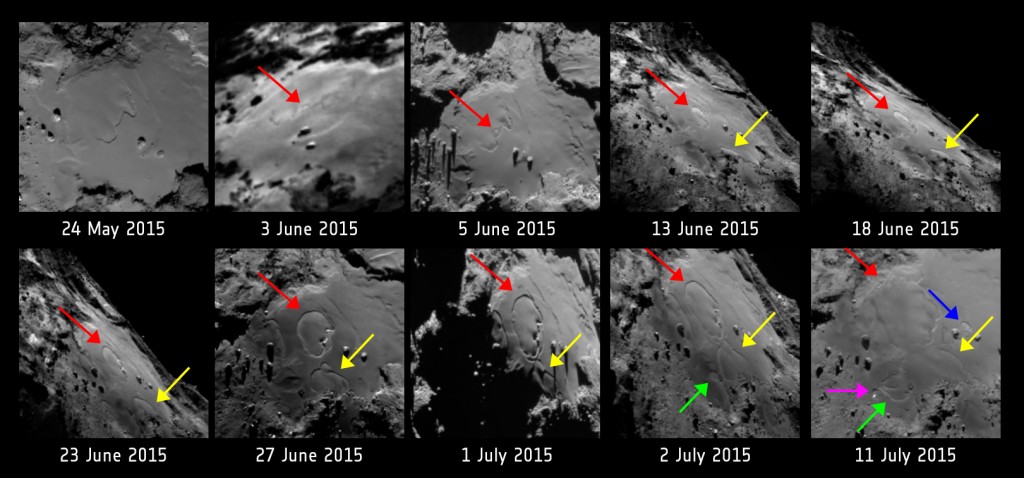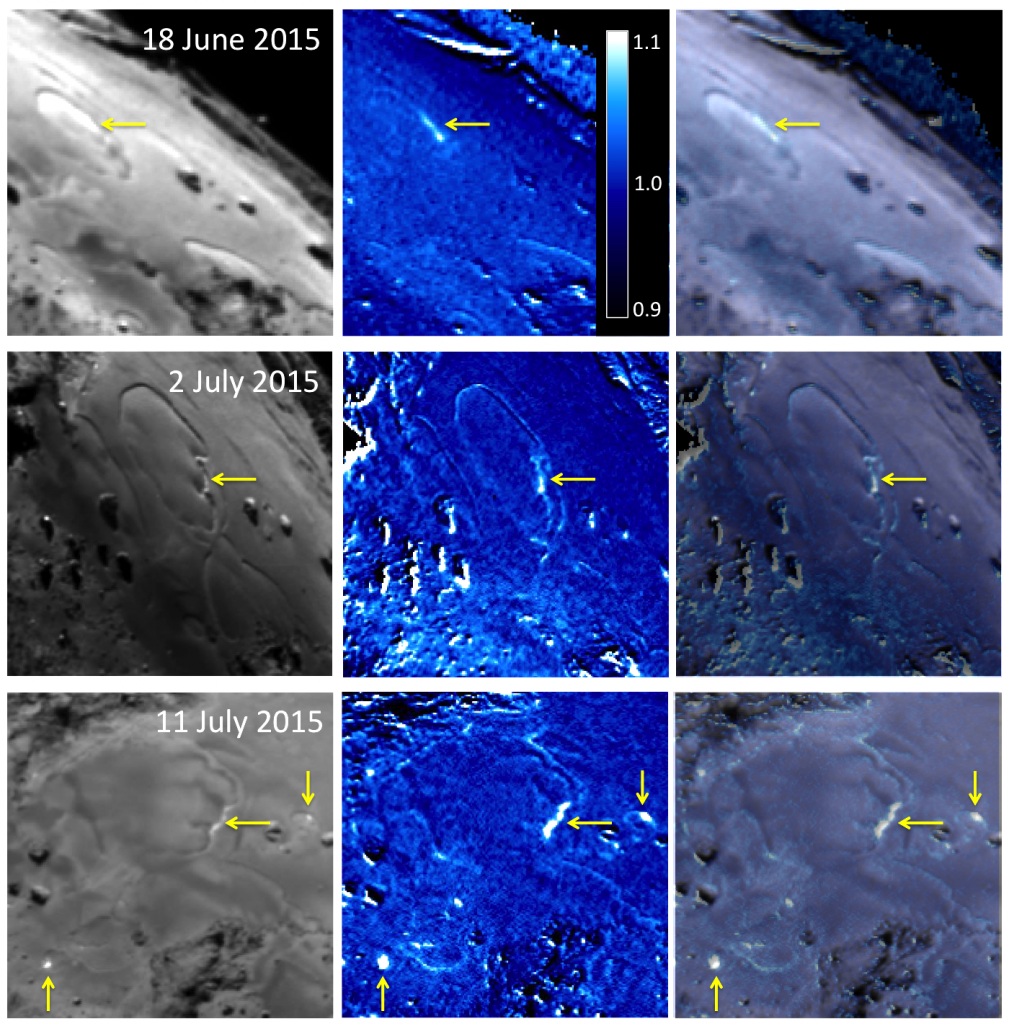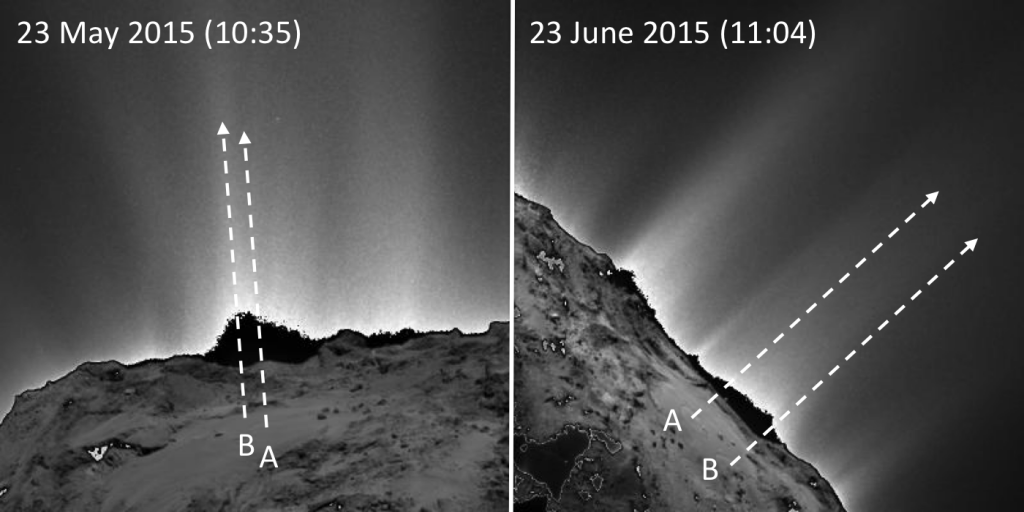
Same sequence as above, with indication of dates and location of the morphological changes. Credits: ESA/Rosetta/MPS for OSIRIS Team MPS/UPD/LAM/IAA/SSO/INTA/UPM/DASP/IDA
In the months leading to the perihelion of Comet 67P/Churyumov-Gerasimenko, Rosetta scientists have been witnessing dramatic and rapid surface changes on the Imhotep region. Since arriving at Comet 67P/C-G in August 2014, Rosetta has been witnessing an increase in the activity of the comet, warmed by the ever-closer Sun. A general increase in the outflow of gas and dust has been punctuated by the emergence of jets and dramatic rapid outbursts in the weeks around perihelion, the closest point to the Sun on the comet’s orbit, which occurred on 13 August 2015.
But in June 2015, just 2 months before perihelion, Rosetta scientists started noticing important changes on the surface of the nucleus itself in Imhotep, which has smooth terrains covered by fine-grained material as well as large boulders, located on 67P/C-G’s large lobe. First evidence for a new, roughly round feature in Imhotep was seen in an image taken with Rosetta’s OSIRIS narrow-angle camera on 3 June. Subsequent images later in June showed this feature growing in size, and being joined by a second round feature. By 2 July, they had reached diameters of roughly 220 m and 140 m, respectively, and another new feature began to appear.
By the time of the last image used in this study, taken on 11 July, these 3 features had merged into one larger region and yet another 2 features had appeared. “These spectacular changes are proceeding extremely rapidly, with the rims of the features expanding by a few 10s of cm’s / hr. This highlights the complexity of the physical processes involved,” adds Olivier.

Colour images of the Imhotep region on Comet 67P/C-G, taken with the OSIRIS narrow-angle camera on Rosetta on 18 June (upper row), 2 July (middle row) and 11 July 2015 (lower row). The first column shows images taken in the orange filter (649 nanometres); the second column shows the ratio between images taken with the blue filter (481 nanometres) and the orange filter for the 18 June and 2 July images, and the ratio between images taken with the blue and the red (701 nanometres) filters for the 11 July image; the third column shows a composite obtained by combining the images in the previous two columns. The yellow arrows indicate some of the new features that were detected on Imhotep. These colour images show that some patches on the surface of the comet reflect orange/red light less effectively and blue light more effectively than their surroundings. They appear as white in the central column, where the colour ratio is shown. This indicates the presence of frozen water ice at or just below the surface of these patches. Credits: ESA/Rosetta/MPS for OSIRIS Team MPS/UPD/LAM/IAA/SSO/INTA/UPM/DASP/IDA
The sublimation of volatile species is an important factor, as colour images of this region reveal the signature of exposed ice on some of the rims of the newly-formed surface features. The rapid rate of expansion is unexpected, however: models of sunlight-driven sublimation would predict erosion rates of just a few centimetres per hour, so additional mechanisms are required to explain the observations.
A simple possibility is the surface material is very weak, allowing for more rapid erosion, but it is also possible that the crystallisation of amorphous ice or the destabilisation of so-called ‘clathrates’ (a lattice of one kind of molecule containing other molecules) could liberate energy and thus drive the expansion of the features at faster speeds. The erosion could be accompanied by increased rates of gas outflow, including H2O, CO2, or CO. The scientists also searched in OSIRIS images for evidence of increased dust rising from Imhotep as the surface morphology evolved, but did not find any.
While it is unlikely that many small (micron-sized) dust particles were released as the features formed and expanded, it is possible that the same amount of mass was released in a smaller number of larger (millimetre-sized) particles, which would produce less reflected light and thus be harder to detect with OSIRIS.

Activity seen above the Imhotep region with the OSIRIS narrow-angle camera on Rosetta on 23 May 2015 (left), before significant morphological changes were seen in this region, and on 23 June 2015 (right), after the changes had begun to appear. (Times are in UT.) The positions of the first two new features that were seen in Imhotep are marked with A and B. The white arrows indicate the direction along which an increase of activity would have been seen in the case of jets lifting from the newly arisen features. Credits: ESA/Rosetta/MPS for OSIRIS Team MPS/UPD/LAM/IAA/SSO/INTA/UPM/DASP/IDA
In addition, a significant fraction of the dust released may have immediately fallen back to the surface, accumulating at the base of the expanding rims. Although the scientists were initially surprised to see such significant changes taking place on smooth terrains such as those seen in Imhotep, the location of this region close to the comet’s equator guarantees that it receives large amounts of sunlight.
“We are looking forward to combining our OSIRIS observations with data from other instruments on Rosetta, to piece together the origin of these curious features,” concludes Olivier.
http://blogs.esa.int/rosetta/2015/09/18/comet-surface-changes-before-rosettas-eyes/








Recent Comments